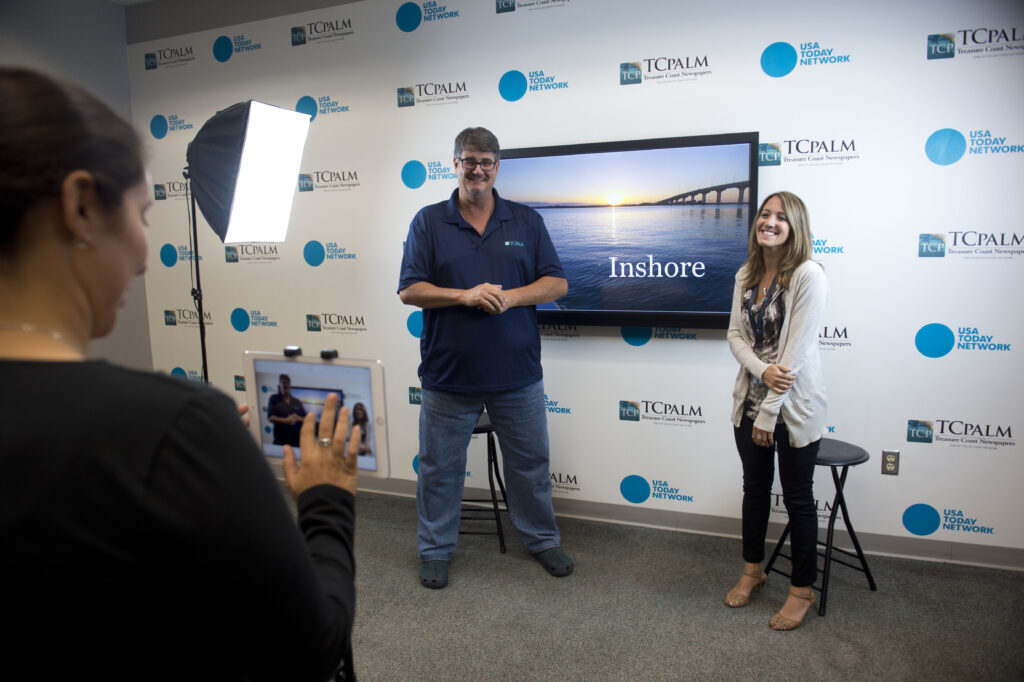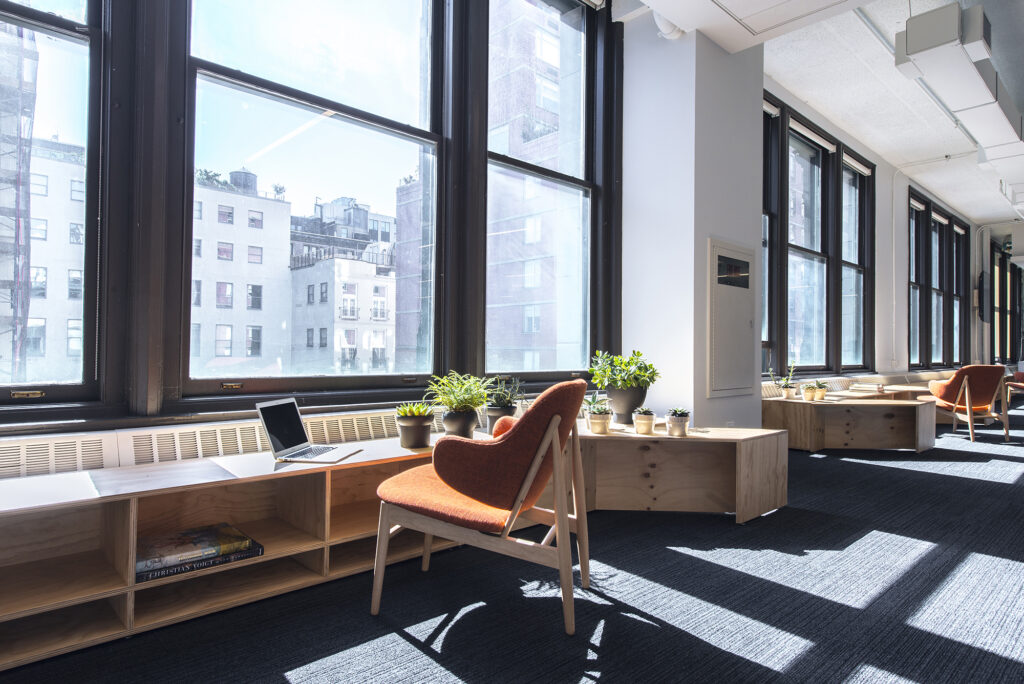News is hardly the only industry disrupted by technology over the past decade. But you’d be hard-pressed to find a newsroom that doesn’t feel like it has borne the brunt of that disruption. As newsroom leaders have adapted their staff and workflows, they’ve realized traditional office spaces can’t keep pace with a business in constant flux.
While there is no one-size-fits-all solution for news organizations, or any guarantee they can create change-proof environments, experts say workspaces are more likely to weather change if they’re built around two guiding principles.
Design for mobility
Mobility is about creating fluid spaces where people can move about freely and change furniture, locations and activities as needed. Those changes could be made to adapt to an employee’s varied tasks within the course of a day. Or they could be precipitated by a fundamental shift in the industry itself.
This approach requires design decisions aimed at creating flexible environments that won’t need to be overhauled in a few years.
One trend is unassigned seating, which at one extreme shifts employees from “ownable” workstations to open-season docking stations. Employees move through Google’s sprawling headquarters, for example, as their mood and needs dictate.
For newsrooms, a hybrid model of unassigned seating may be more appropriate. This provides “me” spaces for certain types of work — or certain types of journalists — while providing “we” spaces for collaborative work. (For more on this, see “How to design workspaces that spur collaboration“). Providing a balance of structured and unstructured areas allows employees to move between different parts of the office as a change of scenery or to shift from solo to team work.
A newsroom designed with this balance can have small, “ownable” spaces, such as a desk in an open area or a desktop station on a long table, along with comfortable, unassigned spaces that can be used in a variety of ways.
In Gensler’s 2016 U.S. Workplace Survey, researchers found that “media organizations have a higher percentage of unassigned spaces than even the top innovative companies,” said Sumita Arora, a principal and co-leader of the architectural firm’s media arm.
Arora calls these open areas “third spaces.” They give employees a choice in where they work at different times of the day and encourage different types of collaboration. This kind of flexibility, she said, is a corollary of innovation.

Mixed-use, unassigned seating areas, such as this flank of comfortable window seating at Quartz (top) or the comfortable space at the Center for Investigative Reporting (bottom), offer employees a change of scenery and accommodate different working styles. (Top photo by Mark Craemer; bottom photo by Rachel de Leon)
There are surprisingly simple ways to offer this flexibility: Use furnishings on wheels, lightweight pieces that can be moved, or modular systems that can be reconfigured like Legos.
“Designing for the future has to last 15 to 20 years,” Arora said. “It needs to be plug and play.”

Dozens of flexible, mixed-use spaces are sprinkled throughout The Washington Post’s new building. Each space has its own personality, color scheme and aesthetic. Furniture can be moved easily to suit solo or collaborative work. (Photo by Garrett Rowland)
Unassigned seating, mixed-use spaces and Lego-like furnishings can subtly instill a culture of innovation. When employees are surrounded by things that change in their environment, like a table on wheels, that’s a signal that change is constant and productive. Flexible, mixed-use spaces can influence behavior just like open-ended children’s toys invite imaginative play. Just as toys with predetermined uses inhibit inventiveness, having too many spaces that are designated for one activity (a lunchroom, a video studio, a conference room) diminishes the possibilities for how your employees work.
Design for agility
If ”mobility” reflects where you work, “agility” is about how you work — a mindset that influences culture and shapes newsroom practice and design.
Newsrooms are adopting design features that herald the shift from an assembly-line model of production to a more interactive, nonlinear workflow. “The spaces we had were built for a linear production process, people doing their thing and passing it on to the next person,” The Dallas Morning News’ Robyn Tomlin said. “Things don’t happen in the same lines.”
Arora refers to this as the “live-streaming workplace,” in which the focus is on fluid, continuous production and dissemination of digital content.
News organizations can encourage their employees to rethink how they do their work — even what work they should be doing — by creating incubator spaces. These areas reinforce the idea that newsrooms should be in a perpetual state of invention and iteration.
At Quartz, the Workshop serves as a purposeful play zone, a place for imaginative product development. Sam Williams, director of the Workshop, has overseen formal and informal product incubation through hacks, sensors and bots. These experiments have turned into viable news products, such as a text-message interface for Quartz’s iPhone app.
Quartz’s incubator activity expanded with the launch of the Bot Studio, led by fellow tinkerer and noted sensor journalist John Keefe.
The Alpha Group, which provides product development and technology strategy for Advance Publications, has a similar incubator mindset. But the Alpha Group is purposely separate from Advance’s newsrooms. This alternative model allows companies to pursue experiments away from the day-to-day business.
“This is more of a heads-down process,” said David Cohn, senior director for the Alpha Group. “We work independently and are supposed to be quick and build MVPs [minimum viable products], not worrying about existing audiences and legacy workflows.”
This autonomy gives them the freedom and flexibility to do curiosity-driven research that doesn’t always have an immediate application. “Once we come up with something we want to double-down on,” Cohn said, “we show it to the larger organization to get a greenlight.”
After the alpha phase is complete, Cohn’s team hands off the product to the larger media organization. “We don’t want to dictate,” he said. “We want them to feel empowered — they can take the product into directions we haven’t thought of, because they’re responding to users on the ground.”
Greater role for video shapes newsroom design
At many of the news outlets that participated in this study, agility means an elevated role for video, both in how teams are organized and in how their workspaces are laid out.
The way video is incorporated into the daily routine of modern news outlets blurs on-air and off-air space in the newsroom, Arora said. A reporter can go from filing a story for the website to discussing her findings on video, without having to leave her desk.
The Washington Post’s new newsroom has a “glassbox studio” with the central editing hub as a backdrop. Reporters can go on air from anywhere in the newsroom because the editing hub was designed with camera angles in mind.
“We wanted to create brand immersion,” Arora said.

The “glassbox” studio in The Washington Post’s newsroom is just one of several high-tech spaces devoted to multimedia production. It reflects the Post’s high priority on video content.
New seating arrangements also show the importance of video at the Post. In the old building, videographers were siloed off in their own area. Now members of the video team are embedded in sections, similar to how the paper has integrated software developers and graphic designers.
In the newsroom of Treasure Coast News, an old clip file room in a back corner room was transformed into a video studio.

At Treasure Coast News in Florida, a branded wall and a touchscreen display are part of a multi-purpose studio space for interviews, weather reports, live streaming and other video content. (Photo by Leah Voss)
“We’ve been doing a decent job trying to catch up with video,” Managing Editor Adam Neal said. But the newsroom “needed to see a physical transformation to make sure everyone knows how serious we are about video.”
He’s proud “that we’re calling it a video studio — not a TV studio – even though we’re competing with TV. It’s a quick-hit video studio,” where no one needs to be trained on an expensive production system. In fact, one of their first interviews in the studio used Facebook Live.
How newsrooms are integrating analytics into their workspaces
Many of the new and remodeled newsrooms in this study incorporate screens focused on analytics.
By installing prominent screens in the newsroom, audience behavior becomes part of the work environment. These screens can display website analytics, audience engagement across social platforms and trending topics.
These insights are key to understanding audience behavior and monetizing digital content. “We focus all of our energy on the digital space,” Neal said, and these metrics show journalists how people are responding to their work.
But there are a couple notable exceptions. The digitally native Quartz took a more subtle approach to digital displays when it moved into a new space. Modestly-sized screens are as likely to display team-oriented content — such as high scores for a popular mobile game among the staff — as they are to show what’s trending on Twitter.
Brian Boyer, of Spirited Media, shrugs at the need to have analytics displayed prominently. He doesn’t believe the data is always useful or actionable.
At NPR, “we did a piece on the civil war in Yemen. It only had 50,000 hits. Not a viral hit. … For the team that built that, when they see those numbers, and we’re used to getting half a million views when we work this hard – what do you want the team to feel, that they [failed]?”
He said he’s careful to measure success in different ways. For that particular story, instead of measuring page views, his team measured how many people finished it. “It was like 70 percent,” he said. “Which is amazing!”
If you’re going to put metrics on the wall, he cautioned, measure the things that matter the most to you. “Be thoughtful about what you celebrate,” he cautioned.
In the physical space, “what you choose to celebrate impacts how your team feels and performs.”
Share with your network
- How to design workspaces that spur collaboration
- Start a workplace redesign by identifying the problem you need to solve
- Appendix
- A Matter of Space: Designing newsrooms for new digital practice
- Engaging staff: User experience studies are not just for audiences
- Designing for new priorities and practices
You also might be interested in:
Experts define moral injury as the suffering that comes from witnessing, perpetrating or failing to prevent events that violate one’s own deeply held moral beliefs and values. It is not classified as a mental illness, but it can lead to depression, substance abuse or burnout, which is one reason news managers need to understand the phenomenon of moral injury — and ways to address it or head it off.
For many newsrooms, changing the systems that protect unhealthy culture could be a few sustained decisions away from reality.
With all of the demands on a newsroom, how do you make time to build new habits in pursuit of larger goals?



